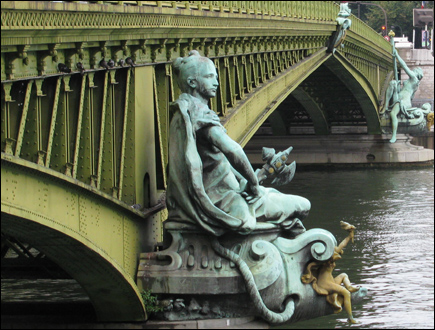
You don’t have to cross the Pont Mirabeau, the Mirabeau Bridge, to know the famous poem of the same name by Guillaume Apollinaire.
* * *
Paris has historical bridges, elegant bridges, workaday bridges, metro bridges, and pedestrian bridges; it has stone bridges, iron bridges, and 2-, 3-, and 5-span bridges. And it has one most evocative bridge in its Mirabeau Bridge, le Pont Mirabeau, famous not for its beauty or for its view but for a poem that it inspired.
Construction of the Mirabeau Bridge near the southwestern edge of Paris, 1893-1896, immediately preceded that of the far more photogentic Alexandre III Bridge, 1897-1900, and the two are structurally similar. Though unable to compete with the situation, cherubs, gilt, and Belle Epoque elegance the Alexandre III, the Mirabeau nevertheless enjoys the more evocative name since it is the title of Guillaume Apollinaire’s much memorized melancholic poem “Le Pont Mirabeau.”
In that poem of 1912 the bridge reminds the poet of lost love and the passage of time. The text of the poem and more information about the bridge are found further down, but before reading on you can watch this France Revisited® audio slideshow to see images of the Pont Mirabeau and hear a reading of Apollinaire’s poem by Va-nu-pieds.
History: The vast urban overhaul of Paris of the second half of the 19th century, from Napoleon III’s appointment of Baron Haussmann as prefect of Paris in 1853 to the opening of the first two lines of the metro in 1900, involved the construction or reconstruction of more than half of the bridges over the Seine.
Engineering: Connecting the Grenelle quarter of the 15th arrondissement (Left Bank) with the Auteuil quarter of the 16th arrondissement (Right Bank), the Mirabeau Bridge was designed by Paul Rabel, assisted by engineers Jean Résal and Amédée Alby, and executed by the company Daydé & Pillé. The same assisting engineers were responsible for the Alexandre III Bridge, which is based on the same principle of two metal structures buttressing each other to create the balance of the span. The Mirabeau has a central arch of 305 feet with one arch to either side of 106 feet connecting with the riverbank. The Alexandre III primarily consists of a single 350-foot arch.
Allegory: On the Mirabeau, four bronze allegorical sculptures by Jean-Antoine Injalbert decorate the pillars like figureheads on the bow and stern of two boats, one on the Left Bank side facing upstream, one on the Right Bank side facing downstream. On the Left Bank side, Navigation holds a harpoon at the stern while Commerce blows a golden trumpet at the bow. On the Right Bank side the City of Paris sits facing those approaching the capital at the bow while Abundance holds a flame at the stern. The arms of the City of Paris decorate the inner railing above the statues.
Abundance’s flame is an odd echo of the 1889 quarter-size replica of the Statue of Liberty raising her own flame just upstream at the tip of the Alley of Swans (Allée des Cygnes), in front of the Grenelle Bridge.

Who is Mirabeau?: Count de Mirabeau (1749-1791), more often simply called Mirabeau, gained prominence as a revolutionary nobleman. He opposed the absolute monarchy in the decade prior to events of 1789 then favored a constitutional monarchy as the tide turned against Louis XVI.
Poetry: However, it isn’t the revolutionary history of Mirabeau that rings in the name “Le Pont Mirabeau” but the poem of that title by Guillaume Apollinaire (1880-1918), written in 1912 and published in his collection “Alcools” in 1913.
Le Pont Mirabeau
Sous le pont Mirabeau coule la Seine
Et nos amours
Faut-il qu’il m’en souvienne
La joie venait toujours après la peine
Vienne la nuit sonne l’heure
Les jours s’en vont je demeure
Les mains dans les mains restons face à face
Tandis que sous
Le pont de nos bras passe
Des éternels regards l’onde si lasse
Vienne la nuit sonne l’heure
Les jours s’en vont je demeure
L’amour s’en va comme cette eau courante
L’amour s’en va
Comme la vie est lente
Et comme l’Espérance est violente
Vienne la nuit sonne l’heure
Les jours s’en vont je demeure
Passent les jours et passent les semaines
Ni temps passé
Ni les amours reviennent
Sous le pont Mirabeau coule la Seine
Vienne la nuit sonne l’heure
Les jours s’en vont je demeure
Apollonaire himself can be heard reading “Le Pont Mirabeau” in a 1914 recording in which he instills his work with the full weight and rhythm of a dirge. On the Wheaton College website click on “dit par l’auteur” (i.e. spoken by the author).
The words of “Le Pont Mirabeau” have been made into several notable songs, including this 1952 song by Léo Ferré with its vie-en-rosy wistfulness:
and this 2001 song by Marc Lavoine with its melodic drama:
© 2010, Gary Lee Kraut

